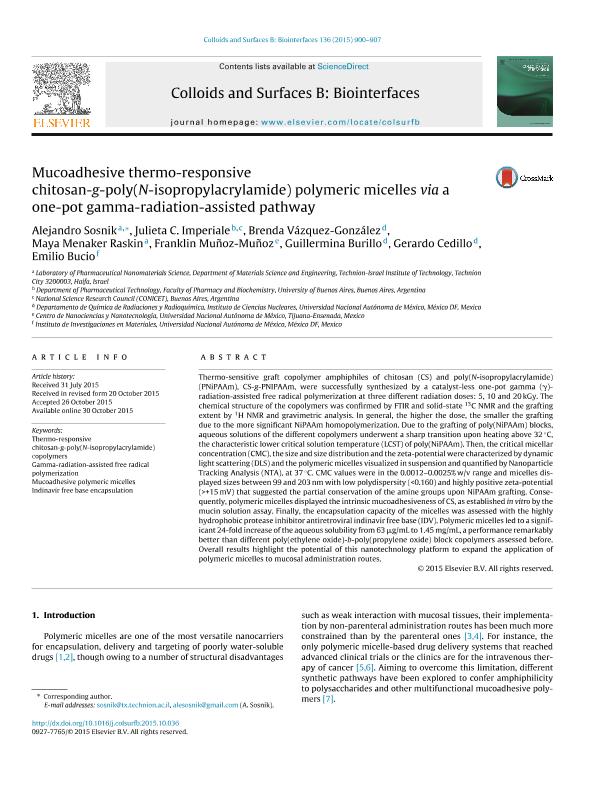Artículo
Mucoadhesive thermo-responsive chitosan-g-poly(N-isopropylacrylamide) polymeric micelles via a one-pot gamma-radiation-assisted pathway
Sosnik, Alejandro Dario ; Imperiale, Julieta Celeste
; Imperiale, Julieta Celeste ; Vázquez González, Brenda; Raskin, Maya Menaker; Muñoz Muñoz, Franklin; Burillo, Guillermina; Cedillo, Gerardo; Bucio, Emilio
; Vázquez González, Brenda; Raskin, Maya Menaker; Muñoz Muñoz, Franklin; Burillo, Guillermina; Cedillo, Gerardo; Bucio, Emilio
 ; Imperiale, Julieta Celeste
; Imperiale, Julieta Celeste ; Vázquez González, Brenda; Raskin, Maya Menaker; Muñoz Muñoz, Franklin; Burillo, Guillermina; Cedillo, Gerardo; Bucio, Emilio
; Vázquez González, Brenda; Raskin, Maya Menaker; Muñoz Muñoz, Franklin; Burillo, Guillermina; Cedillo, Gerardo; Bucio, Emilio
Fecha de publicación:
12/2015
Editorial:
Elsevier Science
Revista:
Colloids and Surfaces B: Biointerfaces
ISSN:
0927-7765
Idioma:
Inglés
Tipo de recurso:
Artículo publicado
Clasificación temática:
Resumen
Thermo-sensitive graft copolymer amphiphiles of chitosan (CS) and poly(N-isopropylacrylamide) (PNiPAAm), CS-g-PNIPAAm, were successfully synthesized by a catalyst-less one-pot gamma (γ)-radiation-assisted free radical polymerization at three different radiation doses: 5, 10 and 20kGy. The chemical structure of the copolymers was confirmed by FTIR and solid-state 13C NMR and the grafting extent by 1H NMR and gravimetric analysis. In general, the higher the dose, the smaller the grafting due to the more significant NiPAAm homopolymerization. Due to the grafting of poly(NiPAAm) blocks, aqueous solutions of the different copolymers underwent a sharp transition upon heating above 32°C, the characteristic lower critical solution temperature (LCST) of poly(NiPAAm). Then, the critical micellar concentration (CMC), the size and size distribution and the zeta-potential were characterized by dynamic light scattering (DLS) and the polymeric micelles visualized in suspension and quantified by Nanoparticle Tracking Analysis (NTA), at 37°C. CMC values were in the 0.0012-0.0025%w/v range and micelles displayed sizes between 99 and 203nm with low polydispersity (<0.160) and highly positive zeta-potential (>+15mV) that suggested the partial conservation of the amine groups upon NiPAAm grafting. Consequently, polymeric micelles displayed the intrinsic mucoadhesiveness of CS, as established in vitro by the mucin solution assay. Finally, the encapsulation capacity of the micelles was assessed with the highly hydrophobic protease inhibitor antiretroviral indinavir free base (IDV). Polymeric micelles led to a significant 24-fold increase of the aqueous solubility from 63μg/mL to 1.45mg/mL, a performance remarkably better than different poly(ethylene oxide)-b-poly(propylene oxide) block copolymers assessed before. Overall results highlight the potential of this nanotechnology platform to expand the application of polymeric micelles to mucosal administration routes.
Archivos asociados
Licencia
Identificadores
Colecciones
Articulos(OCA CIUDAD UNIVERSITARIA)
Articulos de OFICINA DE COORDINACION ADMINISTRATIVA CIUDAD UNIVERSITARIA
Articulos de OFICINA DE COORDINACION ADMINISTRATIVA CIUDAD UNIVERSITARIA
Citación
Sosnik, Alejandro Dario; Imperiale, Julieta Celeste; Vázquez González, Brenda; Raskin, Maya Menaker; Muñoz Muñoz, Franklin; et al.; Mucoadhesive thermo-responsive chitosan-g-poly(N-isopropylacrylamide) polymeric micelles via a one-pot gamma-radiation-assisted pathway; Elsevier Science; Colloids and Surfaces B: Biointerfaces; 136; 12-2015; 900-907
Compartir
Altmétricas



